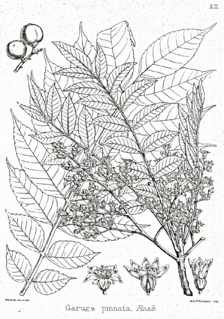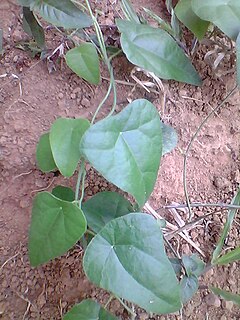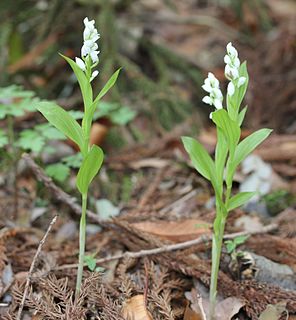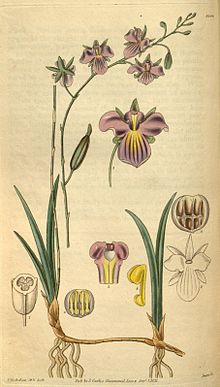
Cyperus is a large genus of about 700 species of sedges, distributed throughout all continents in both tropical and temperate regions.

Octomeria is a plant genus belonging to the family Orchidaceae. The genus comprises about 150 species native to the Neotropics, mostly in Brazil.

Crassocephalum is a genus the common names of whose members include ragleaf, thickhead, and bologi. Several species are raised as leaf vegetables and used for medicine, especially in West Africa. Similar to Senecio, but differing in never having ray florets. A calyculus of short bracts is present. The genus is typically thistle-like in appearance, but all parts are soft and not spiny.

Gossypium hirsutum, also known as upland cotton or Mexican cotton, is the most widely planted species of cotton in the world. Globally, about 90% of all cotton production is of cultivars derived from this species. In the United States, the world's largest exporter of cotton, it constitutes approximately 95% of all cotton production. It is native to Mexico, the West Indies, northern South America, Central America and possibly tropical Florida.

Holothrix is a genus of plants in family Orchidaceae. It contains the following species :

Campylocentrum is a genus of rare orchids native to Mexico, the West Indies, Central America and South America. One species (C. pachyrrhizum) extends its range into Florida.

Pomacea canaliculata, commonly known as the golden apple snail or the channeled apple snail, is a species of large freshwater snail with gills and an operculum, an aquatic gastropod mollusc in the family Ampullariidae, the apple snails. South American in origin, this species is considered to be in the top 100 of the "World's Worst Invasive Alien Species". It is also considered as about the 40th the worst alien species in Europe and the worst alien species of gastropod in Europe.

Sida acuta, the common wireweed, is a species of flowering plant in the mallow family, Malvaceae. It is believed to have originated in Central America, but today has a pantropical distribution and is considered a weed in some areas.

Tetramicra is a genus of flowering plants in the orchid family, Orchidaceae, native to the West Indies. Tetramicra canaliculata has also been reported from southern Florida, but these reports have been challenged.

Prescottia is a genus of flowering plants from the orchid family, Orchidaceae. It is widespread across much of Latin America and the West Indies, with one species (P. oligantha) extending into Florida.

Garuga pinnata is a deciduous tree species from the family Burseraceae.

Nymphaea elegans, the tropical royalblue waterlily, is a species of aquatic plants in the family Nymphaeaceae. It is found in Louisiana, Florida and Texas, in the United States, in Oaxaca in Mexico and in Antioquia in Colombia.

Cocculus orbiculatus, the queen coralbead, is a species of woody vines. It is found from India east to Java.

Cyclea is a genus of flowering plants in the family Menispermaceae.

Hoya multiflora is a species of tropical plants in the family Apocynaceae. It is found in Indonesia. It is an evergreen perennial plant with a maximum height of 50 centimeters. This plant can produce nectar.

Callitriche palustris, the vernal water-starwort, narrow-fruited water-starwort, or spiny water starwort, is a species of aquatic plants. It is the type species of its genus.

Cephalanthera erecta, the erect cephalanthera, is a species of terrestrial orchid. It is found in China, Japan, Korea, Kuril Islands, Bhutan, Assam and eastern Himalayas.

Barkeria uniflora is a species of orchids. It is found in central Mexico. It is the type species of its genus.

Pseudobombax longiflorum is a species of flowering plants of the family Malvaceae. It is found in Bolivia and Brazil.

Thelymitra canaliculata, commonly called the flushed sun orchid or blue sun orchid is a species of orchid in the family Orchidaceae and is endemic to the south-west of Western Australia. It has a single erect, fleshy leaf and up to twenty eight blue flowers with darker veins and sometimes flushed with pink. The lobe on top of the anther is blackish with a yellow crest.




















